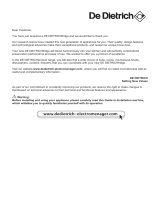
17
STORING FOOD IN THE
REFRIGERATOR
525386
IMPORTANT WARNINGS REGARDING FOOD STORAGE
Correct use of the appliance, appropriate packaging, maintaining
the right temperature, and observing the food hygiene standards
has a decisive impact on the quality of food storage.
Observe the expiry dates for the food, specified on the
packaging.
Food stored in the refrigerator should be kept in closed
containers or appropriate packaging to prevent them from
emitting or receiving odours.
Do not store inflammable, volatile, and explosive substances in
the refrigerator.
Bottles with high alcohol content should be tightly sealed and
stored in an upright position.
Some organic solutions, essential oils in lemon and orange peel,
butter acid, etc. may damage the plastic surfaces in case of a
prolonged contact, causing damage and premature ageing of
these materials.
Unpleasant odour warns of lacking cleanliness of the appliance or
perished contents (see Cleaning the Appliance).
If you are leaving home for a longer period of time, remove
perishables from the refrigerator.
AVOID CONTAMINATION OF FOOD
To avoid contamination of food, please respect the following instructions:
• Opening the door for long periods can cause a signifi cant increase of the temperature in
the compartments of the appliance.
• Regularly clean surfaces that can come in contact with food and accessible drainage
systems.
• Store raw meat and fi sh in suitable containers in the refrigerator, so that it is not in
contact with or drip onto other food.
• If the refrigerating appliance is left empty for long periods, switch o , defrost, clean, dry,
and leave the door open to prevent mould developing within the appliance.























